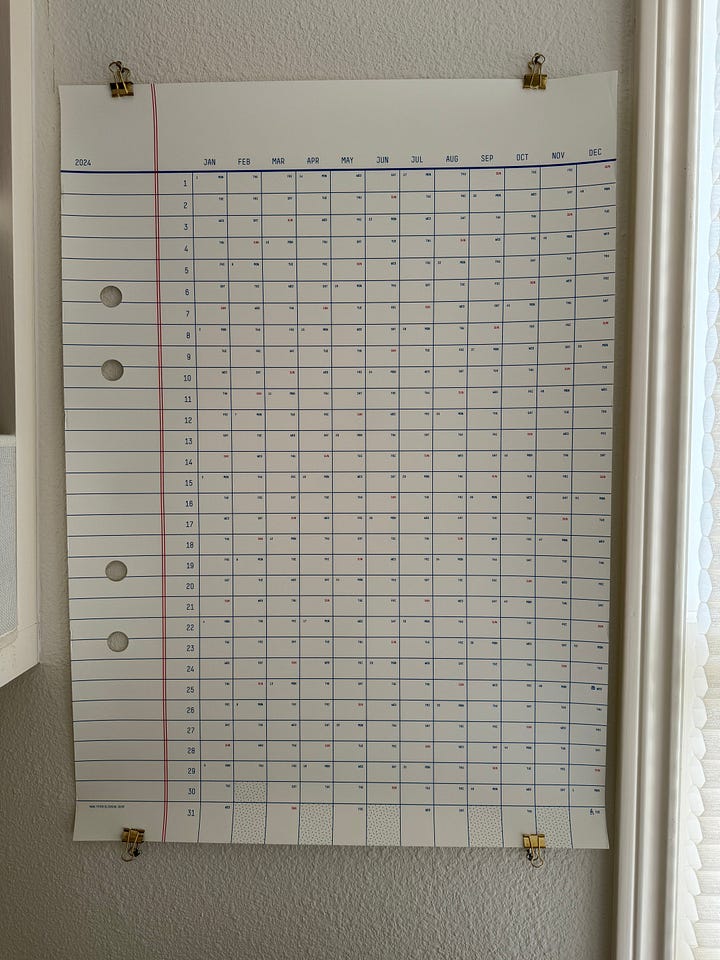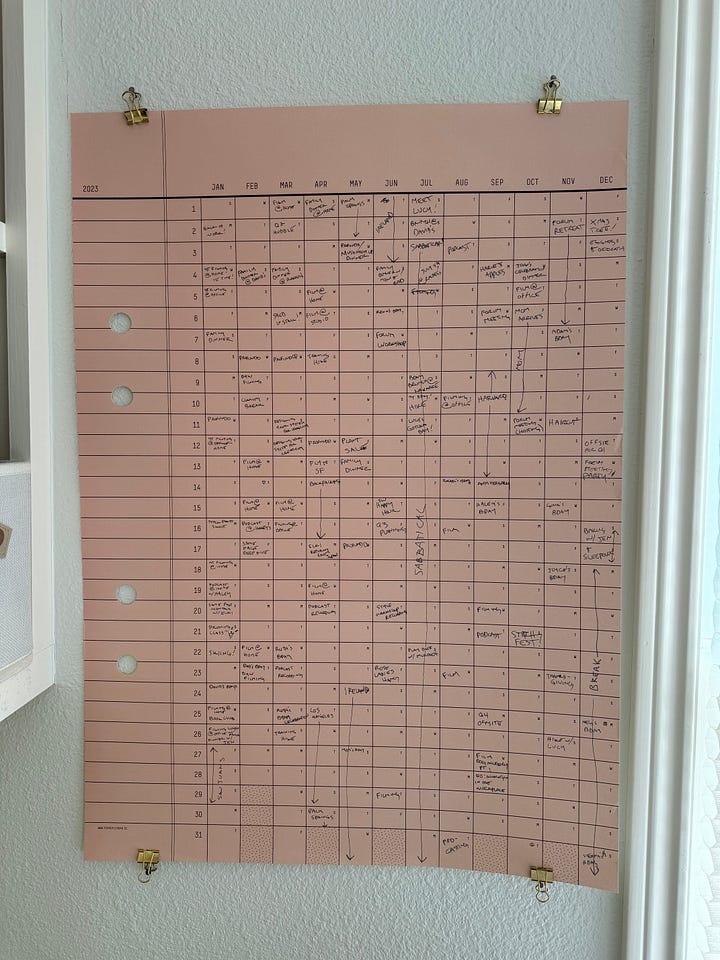Capturing Memories Can Fuel Your Imagination
6 strategies I use to archive my thoughts and spark creative ideas.
Welcome to Making Time. Each week, I explore the impact of time on creativity, ways to slow down, and scenes from my own life in rural Oregon. If you’d like to follow along, you can subscribe for free.
I’m writing to you today from my parents’ dining room table. It’s covered in an old tablecloth printed with sunflowers and lemons, and on top of that are piles of books, notebooks, and mugs of coffee. This is a morning scene I’ve been in countless times, a portrait of home to me.
I’m stranded in southern California, which is as fortunate as it sounds. I came down for a brief visit, but the ice storms in Oregon have prevented me from flying home again. So I’ve been going to the beach, taking lots of walks, and spending time with family, while Kenn texts me pictures of the frozen tundra that surrounds him back home.
There’s a sense of nostalgia, here at the table where I grew up. The sun is shining, just like I remember it used to. The orange tree that’s as tall as the house is still here. My parents are older and so am I, but our patterns are not all that different.
And amidst it all, I have lots of ideas. I think of things I want to do, and feel that I can really do them. Risks seem less risky and more exciting. I feel revived and creative.
Memory and Imagination Work The Same Way
Maria Popova recently wrote:
“Creativity is at bottom the combinatorial work of memory and imagination. All of our impressions, influences, and experiences — every sight we have ever seen, every book read, every landscape walked, every love loved — become seeds for ideas we later combine and recombine, largely unconsciously, into creations we call our own.”
In fact, memory and imagination are not all that different. As far as our minds go, imagining something that hasn’t happened yet is quite similar to remembering something that has.
Try this: close your eyes and think of a memory from your childhood, perhaps a time you made something you were proud of just as an example.
As you remember in this moment, you bring forth a collection of bits and pieces that are stored in your mind, and then reconstruct them into an experience that replays in your hippocampus. Your brain is essentially assembling a story for you in this very moment of remembering. It is a reconstruction.
When you imagine something new, it is a similar process. Constructing a vision of the future and constructing a memory are both ways our brain creates stories to make sense for us. In fact, according to researchers Daniel Schacter and Donna Rose Addis, there is similar brain activity measured by fMRI when people reminisce about the past and when they picture the future.
6 Ways to Capture Memories and Spark Ideas
Capturing memories is one way I feed my creativity. Memories seem to activate the imagination. Perhaps all the feelings and ideas that bubble up while I remember the past naturally begin to form into stories about the future, to unconsciously recombine into new ideas and ways of seeing, as Maria Popova mentions.
Here are some ways that I try to tune into memories, reflecting on them and documenting them for the future, where they can spark new ideas:
Visual journaling: I use a mini printer to create photo stickers that I can put in my journal. It’s wonderful to flip through past years and see my thoughts and images together, and really brings memories to life.
Digital journaling: I also use my micro blog to capture photos and memories, although I’m not as consistent with it. It gives me a quick place to upload little groups of photos, and write a bit if I want to.
Quick journaling: This year, I bought a five year journal so I could write just a couple sentences each night before bed. I love the way these journals surface thoughts from years past, since multiple years are one page. I write about something that happened, something I learned, a quote I liked, or anything else that feels important from my day.
Free writing: When I have a little more on my mind, I use a full size journal to write. I use a Leuchtturm1917 with dotted grid pages. I’ve gone through many of these, and they are my absolute favorite.
Monthly reviews and lists: This is something I’ve been doing for years, and love it. I keep lists in my journal for important memories and learnings each month, which I like to look through at the end of the year.
Wall calendar journal: Last year, I bought a giant yearly wall calendar where I wrote events and had a picture of the entire year. I absolutely loved it, and this year I’m taking a more visual approach and planning to use it as my visual journal by printing small photos and pasting them up into a giant collage of my whole year.


What practices do you have for holding onto memory? Do you feel that capturing memories enhances your creativity? Do you feel more creative when you remember?
Once quick housekeeping note! I’ve been collecting some fantastic links to share, but I’m going to experiment with sending those out in a separate post this week. Stay tuned for that, it should be a fun one.
Thanks for reading Making Time. If you’re new here, you can subscribe for free to receive new posts each week.









I love that you decided to continue this blog. I really enjoyed it last year and look forward to more. This post reminded me of the newsletter Noted by Jillian Hess here on sub stack…which you may have recommended in one of your prior posts. This concept is so fascinating. She writes about the way people take notes, journal and capture their thoughts and memories one wondrous person at a time and often with snapshots of their writings and processes. Highly recommend for your upcoming link party!
I particularly loved this post! As a person who barely has any memory of her childhood, I try to hold on to memories now. I have a junk journal, which I love to work on. It's like having snippets of things you really love in a visual way. I print out picture, save tickers to places I've been, notes given to me, stickers, poems I love, etc. I also just love playing and being creative with stationary.
If there is one thing this post made me realize, is that I should focus more on things I actually want to remember. When it comes to journaling, I often go to my journal and write when I'm mad or frustrated and I try to understand my feelings on paper and it's such a great way to vent. However, it makes for a really sad book! Full of pages with anger and sadness. I will be shifting my approach to this and do what you are doing. Writing on something that happened and what you learned.
Thanks for sharing.